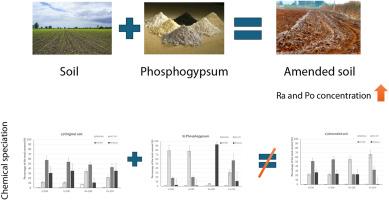Assessment of the radiological environmental impact of using phosphogypsum as soil amendment: soil availability modification and radiological impact evaluation
IF 8.1
2区 环境科学与生态学
Q1 ENVIRONMENTAL SCIENCES
引用次数: 0
Abstract
Phosphogypsum is a by-product of the phosphate industry, which presents enhanced concentrations of heavy metals and naturally occurring radionuclides, mainly 226Ra, 210Po and 210Pb. Taking into account sustainability goal and green chemistry, it is also considered a resource with numerous commercial applications, being its use as soil conditioner and/or amendment one of them. This application can also cause a potential hazard because it may introduce these contaminants into the human foodchain. Plant uptake depends on the association of these radionuclides to soil particles. In this study, we considered a typical Mediterranean soil which was amended with phosphogypsum, and two different sequential extraction schemes were applied to the original soil, phosphogypsum and amended soil. Phosphogypsum application did modify the pattern in which radionuclides were associated to soil particles. From the results of these extractions, it was observed that in amended soil uranium association to diluted-acid and moderately reducible fraction increased; while a reduction of 226Ra exchangeable fraction and an increase of reducible fractions, also for 210Po, was observed. Distribution of 226Ra and 210Po, most important radionuclides in phosphogypsum, cannot be derived from the individual distribution from original soil and phosphogypsum. Finally, the dose rates to non-human biota were below international benchmarks, and therefore no deleterious effects were to be expected.

磷石膏作为土壤改良剂的放射性环境影响评价:土壤有效性改良与放射性影响评价
磷石膏是磷酸盐工业的副产品,其重金属和天然存在的放射性核素浓度增加,主要是226Ra, 210Po和210Pb。考虑到可持续发展目标和绿色化学,它也被认为是一种具有众多商业应用的资源,作为土壤改良剂和/或改良剂之一。这种应用也会造成潜在的危害,因为它可能会将这些污染物引入人类食物链。植物的吸收取决于这些放射性核素与土壤颗粒的关联。本研究以典型的地中海土壤为研究对象,采用磷石膏改性土壤,分别对原土壤、磷石膏和改性土壤采用两种不同的顺序提取方案。磷石膏的施用确实改变了放射性核素与土壤颗粒相关联的模式。从这些提取结果可以看出,在土壤中,铀与稀释酸和中等还原性组分的结合增加;而226Ra的可交换分数降低,210Po的可还原分数增加。磷石膏中最重要的放射性核素226Ra和210Po的分布不能从原始土壤和磷石膏的个别分布中推断出来。最后,对非人类生物群的剂量率低于国际基准,因此预计不会产生有害影响。
本文章由计算机程序翻译,如有差异,请以英文原文为准。
求助全文
约1分钟内获得全文
求助全文
来源期刊

Chemosphere
环境科学-环境科学
CiteScore
15.80
自引率
8.00%
发文量
4975
审稿时长
3.4 months
期刊介绍:
Chemosphere, being an international multidisciplinary journal, is dedicated to publishing original communications and review articles on chemicals in the environment. The scope covers a wide range of topics, including the identification, quantification, behavior, fate, toxicology, treatment, and remediation of chemicals in the bio-, hydro-, litho-, and atmosphere, ensuring the broad dissemination of research in this field.
 求助内容:
求助内容: 应助结果提醒方式:
应助结果提醒方式:


